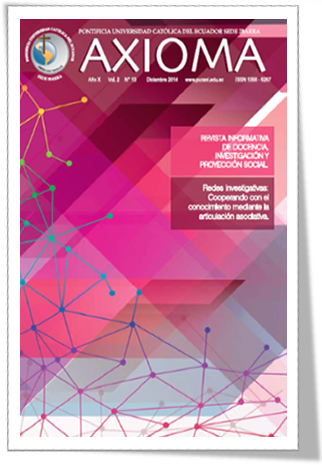Core Collections of Quinoa (Chenopodium quinoa Willd.) from the Gene Bank of INIAP, Ecuador
Main Article Content
Abstract
Quinoa is a grain native of Andean region with high nutritional value, mainly on the content of essential amino acids for human consumption. The quinoa collection of the National Agricultural Research Institute (INIAP), contains over 600 samples, which represents the high diversity of this crop in the Sierra of Ecuador. The Global Plan of Action for the Conservation and Sustainable Utilization of Plant Genetic Resources for Food and Agriculture recommends the establishment of core collections as a necessary condition for improving the use of plant genetic resources, so that this type of research contributes to the identification gene of interest for breeding programs. The aim was to identify groups that allow to define a core collection of quinoa germplasm. For clustering analysis of Ward hierarchical clustering was used; Gower distance using the taxonomic similarity between each pair of contiguous characters accessions was estimated. For qualitative identification of discriminating characters X2 test was used. For quantitative characters Engels statistic was used. Identified four hierarchical groups. The most discriminating qualitative characteristics were: incidence of downy mildew, powdery mildew reaction type reaction to mildew and grain color. The most discriminating quantitative traits were: days to first mature panicle, days to full maturity, yield per plot and severity of mildew. There is an inverse relationship between the attribute earliness and yield, because the earliest accessions (Group 2) are those with the lowest yields. This study found parental gene donors with favorable characters and initiate a plan of breeding by hybridization.
Downloads
Article Details
Con la finalidad de contar con un tipo de licencia más abierta en el espectro que ofrece Creative Commons, a partir de diciembre de 2022 desde el número 27, AXIOMA asume la Licencia Creative Commons 4.0 de Reconocimiento-NoComercial-CompartirIgual 4.0(CC BY-NC-SA 4.0). Tanto el sitio web como los artículos en sus diferentes formatos, reflejan esta información.
![]()
Hasta el mes de noviembre de 2022 con el número 26, la revista AXIOMA asumió una Licencia Creative Commons Atribución-NoComercial-SinDerivadas 4.0 Internacional (CC BY-NC-ND 4.0). Los artículos contenidos en cada número hasta el 26, cuentan con esta licencia y su descripción se conserva en el portal de nuestra revista.
Atribución-NoComercial-SinDerivadas
CC BY-NC-ND
AXIOMA- Revista Científica de Investigación, Docencia y Proyección Social
References
Engels, J.M.M. (1983). A systematic description of cacao clones. In: The discriminative value of quantitative characteristics. Euphytica 32, 377-385.
Frankel, O.H. (1984). Genetic perspectives of germplasm conservation. p. 161-170 en: Genetic manipulation: Impact on man and society (W. Arber, K. Llimensee, W.J. Peacock y P. Starlinger, Eds.). Cambridge University Press, Cambridge, Reino Unido.
Food and Agriculture Organization of the United Nations, FAO. (1996). Global plan of action for the conservation and sustainable utilization of plant genetic resources for food and agriculture. Roma.
Gower, J. (1967). A comparison of some methods of cluster analysis. Biometrics 23:623-637.
Mazón, N., Rivera. M., Peralta, E., Estrella, J., y Tapia, C. (2002). Catálogo del banco de germoplasma de quinua (Chenopodium quinoa Willd.) de INIAP, Ecuador. Programa Nacional de Leguminosas y Granos Andinos y Departamento Nacional de Recursos Fitogenéticos y Biotecnología. Estación Experimental Santa Catalina, INIAP. Quito, Ecuador.
Peralta, E., Villacrés, E., y Mazón, N. (2013). Granos andinos: quinua, chocho, amaranto y ataco. Valor nutricional y funcional. Boletín divulgativo No. 410. INIAP. Quito, Ecuador.
Van Hintum, Th. J. L., Brown, A. H. D., Spillane, C., y Hodgkin, T. (2003). Colecciones núcleo de recursos fitogenéticos. Boletín Técnico No. 3 del IPGRI. Instituto Internacional de Recursos Fitogenéticos, Roma, Italia.
Ward, Jr. J.H. (1963). Hierarchical grouping to optimize an objective function. Journal of the American Statistical Association (USA) 58:236-244.

